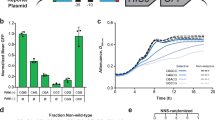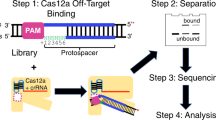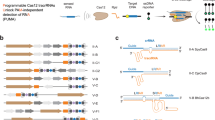Abstract
Sequence-specific recognition of double-stranded nucleic acids is essential for molecular diagnostics and in situ imaging. Clustered regularly interspaced short palindromic repeats and Cas systems rely on protospacer-adjacent motif (PAM)-dependent double-stranded DNA (dsDNA) recognition, limiting the range of targetable sequences and leading to undesired off-target effects. Using single-molecule fluorescence resonance energy transfer analysis, we discover the enzymatic activity of bacteriophage λ exonuclease (λExo). We show binding of 5′-phosphorylated single-stranded DNA (pDNA) to complementary regions on dsDNA and DNA–RNA duplexes, without the need for a PAM-like motif. Upon binding, the λExo–pDNA system catalytically digests the pDNA into nucleotides in the presence of Mg2+. This process is sensitive to mismatches within a wide range of the pDNA-binding region, resulting in exceptional sequence specificity and reduced off-target effects in various applications. The absence of a requirement for a specific motif such as a PAM sequence greatly broadens the range of targets. We demonstrate that the λExo–pDNA system is a versatile tool for molecular diagnostics, DNA computing and gene imaging applications.
This is a preview of subscription content, access via your institution
Access options
Access Nature and 54 other Nature Portfolio journals
Get Nature+, our best-value online-access subscription
27,99 € / 30 days
cancel any time
Subscribe to this journal
Receive 12 print issues and online access
209,00 € per year
only 17,42 € per issue
Buy this article
- Purchase on SpringerLink
- Instant access to full article PDF
Prices may be subject to local taxes which are calculated during checkout






Similar content being viewed by others
Data availability
Source data are provided with this paper.
Code availability
The code used in this study was described in a previous study51 and is available from GitHub (https://github.com/Su-Laboratory/smFRET).
References
Kaminski, M. M., Abudayyeh, O. O., Gootenberg, J. S., Zhang, F. & Collins, J. J. CRISPR-based diagnostics. Nat. Biomed. Eng. 5, 643–656 (2021).
Larson, M. H. et al. CRISPR interference (CRISPRi) for sequence-specific control of gene expression. Nat. Protoc. 8, 2180–2196 (2013).
Gootenberg, J. S. et al. Nucleic acid detection with CRISPR–Cas13a/C2c2. Science 356, 438–442 (2017).
Hsu, P. D., Lander, E. S. & Zhang, F. Development and applications of CRISPR–Cas9 for genome engineering. Cell 157, 1262–1278 (2014).
Kellner, M. J., Koob, J. G., Gootenberg, J. S., Abudayyeh, O. O. & Zhang, F. SHERLOCK: nucleic acid detection with CRISPR nucleases. Nat. Protoc. 14, 2986–3012 (2019).
Zheng, Y. et al. CRISPR interference-based specific and efficient gene inactivation in the brain. Nat. Neurosci. 21, 447–454 (2018).
Guilinger, J. P., Thompson, D. B. & Liu, D. R. Fusion of catalytically inactive Cas9 to FokI nuclease improves the specificity of genome modification. Nat. Biotechnol. 32, 577–582 (2014).
Chen, B. H. et al. Dynamic imaging of genomic loci in living human cells by an optimized CRISPR/Cas system. Cell 155, 1479–1491 (2013).
Deng, W. L., Shi, X. H., Tjian, R., Lionnet, T. & Singer, R. H. CASFISH: CRISPR/Cas9-mediated in situ labeling of genomic loci in fixed cells. Proc. Natl Acad. Sci. USA 112, 11870–11875 (2015).
Fu, Y. et al. High-frequency off-target mutagenesis induced by CRISPR–Cas nucleases in human cells. Nat. Biotechnol. 31, 822–826 (2013).
Zhu, Z. et al. PAM-free loop-mediated isothermal amplification coupled with CRISPR/Cas12a cleavage (Cas-PfLAMP) for rapid detection of rice pathogens. Biosens. Bioelectron. 204, 114076 (2022).
Mitsis, P. G. & Kwagh, J. G. Characterization of the interaction of lambda exonuclease with the ends of DNA. Nucleic Acids Res. 27, 3057–3063 (1999).
Zhang, J., McCabe, K. A. & Bell, C. E. Crystal structures of λ exonuclease in complex with DNA suggest an electrostatic ratchet mechanism for processivity. Proc. Natl Acad. Sci. USA 108, 11872–11877 (2011).
Pan, X. et al. A structure–activity analysis for probing the mechanism of processive double-stranded DNA digestion by λ exonuclease trimers. Biochemistry 54, 6139–6148 (2015).
Tian, J. et al. dsDNA/ssDNA-switchable isothermal colorimetric biosensor based on a universal primer and λ exonuclease. Sens. Actuators B Chem. 323, 128674 (2020).
Liu, L., Lei, J., Gao, F. & Ju, H. A DNA machine for sensitive and homogeneous DNA detection via λ exonuclease assisted amplification. Talanta 115, 819–822 (2013).
Yu, Y. et al. Digestion of dynamic substrate by exonuclease reveals high single-mismatch selectivity. Anal. Chem. 90, 13655–13662 (2018).
Roy, R., Hohng, S. & Ha, T. A practical guide to single-molecule FRET. Nat. Methods 5, 507–516 (2008).
Hohlbein, J., Craggs, T. D. & Cordes, T. Alternating-laser excitation: single-molecule FRET and beyond. Chem. Soc. Rev. 43, 1156–1171 (2014).
Sustarsic, M. & Kapanidis, A. N. Taking the ruler to the jungle: single-molecule FRET for understanding biomolecular structure and dynamics in live cells. Curr. Opin. Struct. Biol. 34, 52–59 (2015).
Wu, T. et al. Noncanonical substrate preference of λ exonuclease for 5′-nonphosphate-ended dsDNA and a mismatch-induced acceleration effect on the enzymatic reaction. Nucleic Acids Res. 46, 3119–3129 (2018).
Wu, T. et al. DNA terminal structure-mediated enzymatic reaction for ultra-sensitive discrimination of single nucleotide variations in circulating cell-free DNA. Nucleic Acids Res. 46, e24 (2018).
Zhang, J. J., McCabe, K. A. & Bell, C. E. Crystal structures of λ exonuclease in complex with DNA suggest an electrostatic ratchet mechanism for processivity. Proc. Natl Acad. Sci. USA 108, 11872–11877 (2011).
Zhang, J., Pan, X. & Bell, C. E. Crystal structure of λ exonuclease in complex with DNA and Ca2+. Biochemistry 53, 7415–7425 (2014).
Singh, D. et al. Mechanisms of improved specificity of engineered Cas9s revealed by single-molecule FRET analysis. Nat. Struct. Mol. Biol. 25, 347–354 (2018).
Cromwell, C. R. et al. Incorporation of bridged nucleic acids into CRISPR RNAs improves Cas9 endonuclease specificity. Nat. Commun. 9, 1448 (2018).
Kim, Y.-M., Choi, K. H., Jang, Y.-J., Yu, J. & Jeong, S. Specific modulation of the anti-DNA autoantibody–nucleic acids interaction by the high affinity RNA aptamer. Biochem. Biophys. Res. Commun. 300, 516–523 (2003).
Machinek, R. R., Ouldridge, T. E., Haley, N. E., Bath, J. & Turberfield, A. J. Programmable energy landscapes for kinetic control of DNA strand displacement. Nat. Commun. 5, 5324 (2014).
Monis, P. T. & Giglio, S. Nucleic acid amplification-based techniques for pathogen detection and identification. Infect. Genet. Evol. 6, 2–12 (2006).
Nouri, R. et al. CRISPR-based detection of SARS-CoV-2: a review from sample to result. Biosens. Bioelectron. 178, 113012 (2021).
Thong, K. L., Lai, M., Teh, C. S. J. & Chua, K. H. Simultaneous detection of methicillin-resistant Staphylococcus aureus, Acinetobacter baumannii, Escherichia coli, Klebsiella pneumoniae and Pseudomonas aeruginosa by multiplex PCR. Trop. Biomed. 28, 21–31 (2011).
De Oliveira, D. M. et al. Antimicrobial resistance in ESKAPE pathogens. Clin. Microbiol. Rev. 33, e00181-19 (2020).
Harvey, W. T. et al. SARS-CoV-2 variants, spike mutations and immune escape. Nat. Rev. Microbiol. 19, 409–424 (2021).
Wang, Y. et al. Detection of SARS-CoV-2 and its mutated variants via CRISPR–Cas13-based transcription amplification. Anal. Chem. 93, 3393–3402 (2021).
Liang, Y. et al. CRISPR–Cas12a-based detection for the major SARS-CoV-2 variants of concern. Microbiol. Spectr. 9, e01017–e01021 (2021).
Gootenberg, J. S. et al. Multiplexed and portable nucleic acid detection platform with Cas13, Cas12a and Csm6. Science 360, 439–444 (2018).
Jackson, C. B., Zhang, L., Farzan, M. & Choe, H. Functional importance of the D614G mutation in the SARS-CoV-2 spike protein. Biochem. Biophys. Res. Commun. 538, 108–115 (2021).
Martin, D. P. et al. The emergence and ongoing convergent evolution of the SARS-CoV-2 N501Y lineages. Cell 184, 5189–5200 (2021).
Zhao, S. et al. Boolean logic gate based on DNA strand displacement for biosensing: current and emerging strategies. Nanoscale Horiz. 6, 298–310 (2021).
Zhang, D. Y. & Winfree, E. Control of DNA strand displacement kinetics using toehold exchange. J. Am. Chem. Soc. 131, 17303–17314 (2009).
Song, T. et al. Fast and compact DNA logic circuits based on single-stranded gates using strand-displacing polymerase. Nat. Nanotechnol. 14, 1075–1081 (2019).
Zhang, C. et al. The recent development of hybridization chain reaction strategies in biosensors. ACS Sens. 5, 2977–3000 (2020).
Li, L. et al. Base excision repair-inspired DNA motor powered by intracellular apurinic/apyrimidinic endonuclease. Nanoscale 11, 1343–1350 (2019).
van Tricht, C., Voet, T., Lammertyn, J. & Spasic, D. Imaging the unimaginable: leveraging signal generation of CRISPR–Cas for sensitive genome imaging. Trends Biotechnol. 41, 769–784 (2023).
Bi, S., Yue, S. Z. & Zhang, S. S. Hybridization chain reaction: a versatile molecular tool for biosensing, bioimaging and biomedicine. Chem. Soc. Rev. 46, 4281–4298 (2017).
Liang, Y. et al. Visualizing single-nucleotide variations in a nuclear genome using colocalization of dual-engineered CRISPR probes. Anal. Chem. 94, 11745–11752 (2022).
Jiang, W., Bikard, D., Cox, D., Zhang, F. & Marraffini, L. A. RNA-guided editing of bacterial genomes using CRISPR–Cas systems. Nat. Biotechnol. 31, 233–239 (2013).
Yu, J., Im, H. & Lee, G. Unwinding mechanism of SARS-CoV helicase (nsp13) in the presence of Ca2+, elucidated by biochemical and single-molecular studies. Biochem. Biophys. Res. Commun. 668, 35–41 (2023).
Chen, J., Fu, S., Zhang, C., Liu, H. & Su, X. DNA logic circuits for cancer theranostics. Small 18, e2108008 (2022).
Brown, J. M., De Ornellas, S., Parisi, E., Schermelleh, L. & Buckle, V. J. RASER-FISH: non-denaturing fluorescence in situ hybridization for preservation of three-dimensional interphase chromatin structure. Nat. Protoc. 17, 1306–1331 (2022).
Blanco, M. & Walter, N. G. Analysis of complex single-molecule FRET time trajectories. Methods Enzymol. 472, 153–178 (2010).
Acknowledgements
This work was supported by the State Key Research Development Program of China (2022YFC2603902), the National Natural Science Foundation of China (32271521, 22325801 and 31971361), the Natural Science Foundation of Beijing Municipality (5212013), the Fundamental Research Funds for the Central Universities (PT2406) and the Talent Cultivation of State Key Laboratory of Organic–Inorganic Composites, Beijing University of Chemical Technology (oic-2024020007).
Author information
Authors and Affiliations
Contributions
X.S. conceptualized and designed the study. S.F., J. Li, J.C., X.S., L.Z. and J. Liu designed, performed and analyzed the experiments. X.S., S.F. and H.L. wrote and revised the paper. All authors discussed the results and revised or commented on the paper.
Corresponding author
Ethics declarations
Competing interests
The authors declare no competing interests.
Peer review
Peer review information
Nature Biotechnology thanks Magdy Mahfouz and the other, anonymous, reviewer(s) for their contribution to the peer review of this work.
Additional information
Publisher’s note Springer Nature remains neutral with regard to jurisdictional claims in published maps and institutional affiliations.
Supplementary information
Supplementary Information
Supplementary Figs. 1–31, Tables 2–4, Notes 1 and 2 and unprocessed gels for supplementary figures.
Supplementary Data 1
Statistical source data for Supplementary Figs. 3, 4, 6–8, 11–14, 17–26, 30 and 31.
Source data
Source Data Fig. 1
Statistical source data.
Source Data Fig. 2
Statistical source data.
Source Data Fig. 3
Statistical source data.
Source Data Fig. 4
Statistical source data.
Source Data Fig. 5
Statistical source data.
Source Data Fig. 6
Statistical source data.
Rights and permissions
Springer Nature or its licensor (e.g. a society or other partner) holds exclusive rights to this article under a publishing agreement with the author(s) or other rightsholder(s); author self-archiving of the accepted manuscript version of this article is solely governed by the terms of such publishing agreement and applicable law.
About this article
Cite this article
Fu, S., Li, J., Chen, J. et al. Bacteriophage λ exonuclease and a 5′-phosphorylated DNA guide allow PAM-independent targeting of double-stranded nucleic acids. Nat Biotechnol (2024). https://doi.org/10.1038/s41587-024-02388-9
Received:
Accepted:
Published:
DOI: https://doi.org/10.1038/s41587-024-02388-9



